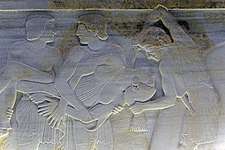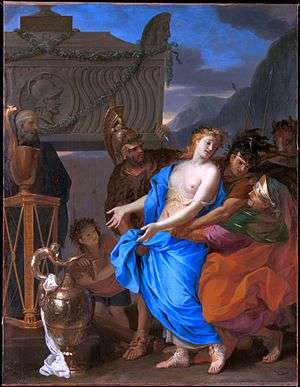Polyxena
In Greek mythology, Polyxena (/pəˈlɪksɪnə/; Greek: Πολυξένη) was the youngest daughter of King Priam of Troy and his queen, Hecuba.[1] She does not appear in Homer, but in several other classical authors, though the details of her story vary considerably. After the fall of Troy, she dies when sacrificed by the Greeks on the tomb of Achilles, to whom she had been betrothed and in whose death she was complicit in many versions.[2]


Myth
Polyxena is considered the Trojan version of Iphigenia, daughter of Agamemnon and Clytemnestra. She is not in Homer's Iliad, appearing in works by later poets, perhaps to add romance to Homer's austere tale. An oracle prophesied that Troy would not be defeated if Polyxena's brother, Prince Troilus, reached the age of twenty. During the Trojan War, Polyxena and Troilus were ambushed when they were attempting to fetch water from a fountain, and Troilus was killed by the Greek warrior Achilles, who soon became interested in the quiet sagacity of Polyxena.[3]
Achilles, still recovering from Patroclus' death, found Polyxena's words a comfort and was later told to go to the temple of Apollo to meet her after her devotions. Achilles seemed to trust Polyxena—he told her of his only vulnerability: his vulnerable heel. It was later in the temple of Apollo that Polyxena's brothers, Paris and Deiphobus, ambushed Achilles and shot him in the heel with an arrow, supposedly guided by the hand of Apollo himself, steeped in poison.
Sacrifice of Polyxena
Some claimed Polyxena committed suicide after Achilles' death out of guilt. According to Euripides, however, in his plays The Trojan Women and Hecuba, Polyxena's famous death was caused at the end of the Trojan War. Achilles' ghost had come back to the Greeks to demand the human sacrifice of Polyxena so as to appease the wind needed to set sail back to Hellas. She was to be killed at the foot of Achilles' grave. Hecuba, Polyxena's mother, expressed despair at the death of another of her daughters. (Polyxena was killed after almost all of her brothers and sisters.)
However, Polyxena was eager to die as a sacrifice to Achilles rather than live as a slave. She reassured her mother, and refused to beg before Odysseus or be treated in any way other than a princess. She asked that Odysseus reassure her mother as she is led away. Polyxena's virginity was critical to the honor of her character, and she was described as dying bravely as the son of Achilles, Neoptolemus, slit her throat: she arranged her clothing around her carefully so that she was fully covered when she died.[1]
In classical art

A few examples in Greek imagery can be securely identified as depicting the sacrifice of Polyxena.[5] Most show Polyxena sacrificed over the tomb of Achilles. However, some details in the pictorial evidence of the sacrifice hint at varying and perhaps earlier versions of the myth.
For instance, some images appear to show Polyxena sacrificed over an altar, rather than a tomb, and one sarcophagus relief, from Gümüşçay, the Polyxena sarcophagus, dated to c. 500 BC[6] shows a tripod placed next to the tomb. These details have been interpreted as indicating an association between the burial mound of Achilles and sacred ground dedicated to Apollo.
Post-classical art
There was a trickle of images in medieval and Renaissance art, often as illustrations to Boccaccio's De mulieribus claris. Primaticcio painted it in the Chateau of Fontainebleau (1541–47). But the subject became more popular in the Baroque, often paired with the Continence of Scipio. Pietro da Cortona "established his reputation" with a large painting in 1625 (now Pinacoteca Capitolina, 2.17 × 4.19 m).[7] Examples include paintings by Giovanni Francesco Romanelli and by Charles Le Brun (1647), both in the Metropolitan Museum of Art, New York. Sebastiano Ricci planned a large painting in the 1720s, but never got beyond studies. [8] The 18th-century Venetian painter Giovanni Battista Pittoni was especially keen on the subject,[9] painting at least nine versions of four compositions.[10]
Most versions show Polyxena going to her death in a dignified manner, though often with her breasts bared. The sacrifice may be performed by a priest, or Neoptolemus. As in Ricci's versions, Achilles' tomb may have an equestrian statue of him above it, and Agamemnon, who opposed the killing, may be present expressing dissent. Sometimes the ghost of Achilles hovers in the air nearby.[11]
The statue usually called The Rape of Polyxena by Pio Fedi (1855–1865), which is very prominently displayed in the Loggia dei Lanzi in Florence, is slightly misleading in the violence that seems to be depicted. The name does not refer to sexual rape, but to an earlier definition of the word derived from the Latin rapere (supine stem raptum), "to snatch, to grab, to carry off"[12][13] It does not show Polyxena's sexual rape, but her taking to be killed by Neoptolemus, despite the protests of her mother Hecuba, seated. The body on the ground, somewhat anachronistically, is either her brother Polites, or possibly Hector. In most versions, both were killed much earlier, and buried by that point in the various stories.[14]
On the stage
The story of Polyxena features in Hecuba by Euripides, Troades by Seneca and the Polyxena of Sophocles, of which only a few fragments remain.[15] Apart from these classical dramas, there are:
- Achille et Polyxène, an opera begun by Jean-Baptiste Lully, who died from a conducting injury having only completed the first act. It was completed by his pupil Pascal Collasse, and premiered in Paris in 1687.
- Polixène, an opera by the French composer Antoine Dauvergne, first performed at the Paris Opéra on 11 January 1763
- Polyxena is also a character in Les Troyens by Hector Berlioz.
See also
- List of King Priam's children
References
- Duckworth, George E (1976). "Polyxena". In William D. Halsey (ed.). Collier's Encyclopedia. 19. Macmillan Educational Corporation. p. 231.
- Hall, 254
- Hall, 249; Aghion et al, 242
- Rose, Charles Brian (2014). The Archaeology of Greek and Roman Troy. Cambridge University Press. p. 79. ISBN 9780521762076.
- M. Robertson “Troilos and Polyxene. Notes on a changing legend,” in J.-P. Dexcoeudres (ed.) Eumousia. Ceramic and iconographic studies in honour of Alexander Cambitoglou, Sydney, 1990, p. 64-65
- Senvinç, N. (1996). "A New Sarcophagus of Polyxena from the Salvage Excavations at Gümüşçay". Studia Troica. 6: 251-64.
- Mylonopoulos, 61
- "The Sacrifice of Polyxena c. 1726–30", Royal Collection
- Hall, 249; Aghion et al, 242
- Mylonopoulos, 61
- Hall, 249; Aghion et al, 242
- Corinne J. Saunders, Rape and Ravishment in the Literature of Medieval England, Boydell & Brewer, 2001, p. 20.
- Keith Burgess-Jackson, A Most Detestable Crime: New Philosophical Essays on Rape, Oxford University Press, New York, 1999, p. 16.
- "The Rape of Polyxena", The Illustrated London News, p. 97, 25 January, 1868; "Tourist breaks a finger off Uffizi’s Rape of Polyxena", The History Blog
- EB
Sources
- Ancient
- Servius. In Aeneida, iii.321.
- Seneca. Troades, 1117–1161.
- Ovid. Metamorphoses, xiii.441–480.
- Modern
- Aghion I., Barbillon C., Lissarrague, F., Gods and Heroes of Classical Antiquity, Flammarion Iconographic Guides, 1996, ISBN 2080135805
- "EB": Chisholm, Hugh, ed. (1911). . Encyclopædia Britannica (11th ed.). Cambridge University Press.
- Hall, James, Hall's Dictionary of Subjects and Symbols in Art, 1996 (2nd edn.), John Murray, ISBN 0719541476
- Mylonopoulos, J, "Gory Details? The Iconography of Human Sacrifice in Greek Art", Human Sacrifice in Cross-cultural perspectives and representations, eds. P Bonnechere & R. Gagne, Presses Universitaires de Lieges, 2013], pp. 61–86
External links
| Wikimedia Commons has media related to Polyxena. |
- The Sacrifice of Polyxena — A painting by Giovanni Battista Pittoni (from the Getty Museum)
